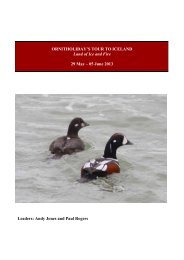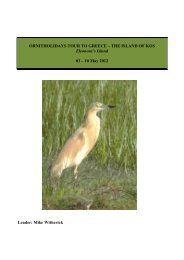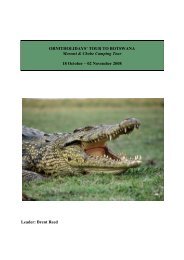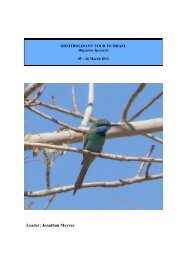Download 2014 Brochure (.pdf) - Ornitholidays
Download 2014 Brochure (.pdf) - Ornitholidays
Download 2014 Brochure (.pdf) - Ornitholidays
You also want an ePaper? Increase the reach of your titles
YUMPU automatically turns print PDFs into web optimized ePapers that Google loves.
TA N Z A N I A<br />
Tanzania – Photographic Tour<br />
Rift Valley, Crater & Plains<br />
Saturday 08 February – Sunday 23 February <strong>2014</strong><br />
Leaders: Richard Coomber and local guides<br />
<strong>2014</strong> Cost: £5,399 single room supplement £500<br />
Thursday 05 March – Friday 20 March 2015<br />
Leaders: Paul Rogers and local guides<br />
2015 Cost: £5,599 single room supplement £520<br />
Lake<br />
Victoria<br />
Serengeti<br />
National Park<br />
Kilimanjaro<br />
Ngorongoro<br />
Arusha<br />
Crater Lake Manyara<br />
Tarangire<br />
National Park<br />
TANZANIA<br />
he Ngorongoro Crater, the plains of the Serengeti, Lake Manyara and snow-capped Mount Kilimanjaro –<br />
T these are all well known areas, frequently seen on wildlife programmes and dreamed about since childhood<br />
stories of adventures in darkest Africa. We have already visited this country at least a dozen times, and now it’s your chance<br />
to see all of these sites at first-hand. Few areas of East Africa can surpass Tanzania for grandeur of scenery, variety of<br />
mammals and spectacular birdlife. The Serengeti has the greatest concentration of large mammals on Earth – perhaps in<br />
excess of two million. It is likely that we shall encounter Lion, Cheetah, Leopard and Black Rhinoceros during our visit, as<br />
well as about 40 other species. The Wildebeest should be migrating in vast herds, accompanied by their attendant<br />
predators, and this tour has been designed to give us the best chance of finding these vast herds. Overhead fly squadrons of vultures, while Bateleurs<br />
plane for mile upon mile looking for prey. Vast Kori Bustards display like exploding powder puffs, while diminutive sunbirds bustle from one brightly<br />
coloured flower to another, as they search for nectar. We visit a wide variety of habitats to ensure a good diversity of birds and game – from the dry<br />
acacia woodland of Tarangire and the dramatic cliffs of the Rift Valley to the vast open plains of the Serengeti. This tour is a birdwatcher’s dream and<br />
the opportunities for photography will be fantastic. We visit Tanzania in “High Season” when the game viewing should be at its best and there should<br />
be many birds that are winter visitors to the area. Tanzania can still give you the thrill of the really wild East Africa – visit it now.<br />
ITINERARY<br />
Days 1 to 4<br />
We leave London in the evening on our<br />
scheduled flight to Kilimanjaro, via Nairobi. We<br />
meet our transport at the airport and drive<br />
through superb scenery to Tarangire where we<br />
stay for the next three nights. Tarangire National<br />
Park has a mixture of habitats, which we can<br />
explore during our time here: there is the dry,<br />
open acacia woodland beloved by rollers, beeeaters<br />
and shrikes, where Secretarybirds stalk<br />
through the long grass and between the spiky<br />
shrubs looking for a small lizard or snake. The<br />
common birds here include Black-winged Kite,<br />
White-backed Vulture, Bateleur, Tawny Eagle,<br />
Helmeted Guineafowl, Blacksmith Plover,<br />
Laughing Dove, Speckled Mousebird, Lilacbreasted<br />
Roller, Common Bulbul, Common<br />
Fiscal, Grey-headed Sparrow and Red-billed<br />
Quelea. Giant baobabs stand as though planted<br />
upside down, and the grassy areas often hold<br />
secretive pairs of Heuglin’s Coursers. Spotflanked,<br />
D’Arnaud’s and White-headed Barbets<br />
all occur here, together with Brown and Orangebellied<br />
Parrots. The areas of open water and<br />
swamp around the Tarangire River hold<br />
Hamerkop, African Darter, Goliath Heron, African<br />
Spoonbill and Three-banded Plover. An endemic<br />
speciality of the area is the Ashy Starling. Game<br />
will be common and we can hope to see herds<br />
of Elephant, together with Giraffe, Waterbuck<br />
and the delightful Kirk’s Dikdik.<br />
Bronze Sunbird<br />
Days 5 & 6<br />
We leave Tarangire, and travel to Kirurumu<br />
Camp, overlooking Lake Manyara, where we<br />
stay for two nights. This tented camp has a small<br />
drinking pool next to the dining tables and we<br />
can look for Cut-throat Finch and Green-winged<br />
Pytilia amongst a host of other birds and small<br />
mammals that come to bathe and refresh<br />
themselves. We shall also visit the lake itself<br />
looking for Silvery-cheeked Hornbills and Syke’s<br />
Monkey, both Lesser and Greater Flamingos,<br />
White and Pink-backed Pelicans, and perhaps<br />
finding the famous tree climbing lions. The<br />
lakeside is often teeming with waterbirds and we<br />
can spend some time here identifying the many<br />
storks, herons, egrets, waders and ducks.<br />
48<br />
For a previous tour report or further information please call: 01794 519445








